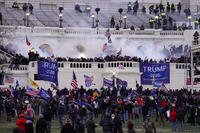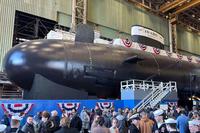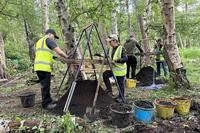Inside the cavernous Lockheed Martin aircraft manufacturing plant at Dobbins Air Reserve Base, employees Thursday celebrated nearly 70 years of flight for the C-130 tactical airlifter -- built in Marietta as the longest-running military aircraft production line in history.
Since the first flight on Aug. 23, 1954, of the large turboprop plane now known as the Hercules, it has been used to drop bombs, spy on targets and attack them with cannons, according to Lockheed Martin. It has also been used for humanitarian missions around the world.
Its cargo hold is fully pressurized and can be reconfigured to carry troops, passengers, equipment or stretchers. Its longevity is due to its versatility for a variety of missions.
Rod McLean, Lockheed Martin's vice president and general manager of the Marietta site, said the anniversary "just signifies how Lockheed Martin is one of the key cornerstones of Cobb County and the metro Atlanta region's economy."
In Cobb County, there are daily flights overhead of C-130s used for training by air reserve crews at Dobbins, or for test flights of new C-130Js just built.
During an all-employee event Thursday for the anniversary, Lockheed Martin also honored four employees who have worked there for at least 60 years.
C-130 history
The birth of the C-130 stretches back to the United States' entry into the Korean War. The U.S. Air Force commissioned what was then Lockheed Aircraft Corp. to build a military cargo transport that could airlift combat troops and deliver them to small airfields.
After successful prototypes were built in Burbank, California, Lockheed moved the C-130 program to its facility in Marietta, then known as Lockheed-Georgia Company.
Since then, more than 2,700 C-130s have been ordered or delivered to more than 60 nations. The version currently manufactured in Marietta is the C-130J Super Hercules.
C-130s have been used for airdrops, deliveries, medical transport or other passenger transport during humanitarian crises, including in New Orleans after Hurricane Katrina and after the 2010 earthquake in Haiti. In January, the Georgia Air National Guard received its first of eight C-130J-30 Super Hercules tactical airlifters, though the Savannah-based 165th Airlift Wing has operated several other variants of the Hercules over the years.
C-130s have also been used to fight fires and are deployed by the Air Force Reserve Command's Hurricane Hunters weather reconnaissance squadron, which flies into the eyes of hurricanes to measure wind speed and barometric pressure and improve accuracy of National Hurricane Center forecasts.
There have also been some tragedies. Among them, in 2018, a C-130 crashed onto Ga. 21 shortly after takeoff from Savannah/Hilton Head International Airport. Nine airmen in the Puerto Rico National Guard were killed.
The future for Hercules
It's yet to be seen what the ultimate life span of C-130 production will be. The volume of C-130Js built in Marietta has declined to about 20 a year from 34 back in 2012. The peak year for C-130 deliveries was early on in the production line, in 1957, when 140 were delivered in one year.
"I would have told you in 2010 that we wouldn't be producing C-130Js in 2020," said Lockheed Martin Aeronautics President Greg Ulmer. "We're going to be producing C-130Js in 2035 and beyond."
That forecast is based on a combination of firm orders for production into the 2030s and expectations to sell more C-130s, according to McLean.
The International Association of Machinists union, which represents workers at the Marietta plant, said it has been "actively working on Capitol Hill to maintain the current production levels" of the C-130J. The union and members of Congress in May pushed for funding for the C-130J program in the federal government's fiscal year 2025 budget, and warned there could be negative consequences of a drop in production.
"IAM Local 709 members in Marietta have consistently produced superior aircraft," said IAM Southern Territory General Vice President Craig Martin in a written statement. "These jobs are crucial not only for this community but also for supporting jobs across Georgia and the nation. We are proud of our members' work and look forward to celebrating future milestones."
A Timeline of the C-130
- Aug. 23, 1954: First flight of YC-130 prototype at Burbank, California
- 1955: The first production C-130 is flown at the Lockheed-Georgia facility in Marietta
- 1956: The C-130A, the first production model of the C-130, enters service
- 1957: A record 140 C-130s are delivered in a single year
- 1961: Lockheed becomes an integrated assembly line and is a pilot plant in the South to then-President John F. Kennedy's equal opportunity policy
- 1994: C-130J Super Hercules production begins in Marietta
- 1998: C-130J enters service
- 2012: Peak production of the C-130J with 34 aircraft produced in a single year
- 2015: The 2500th Hercules is delivered to Moody Air Force Base in Valdosta
- 2024: Lockheed Martin celebrates 70 years since the first flight of the C-130
Source: Lockheed Martin
© 2024 The Atlanta Journal-Constitution.
Visit at ajc.com.
Distributed by Tribune Content Agency, LLC.












